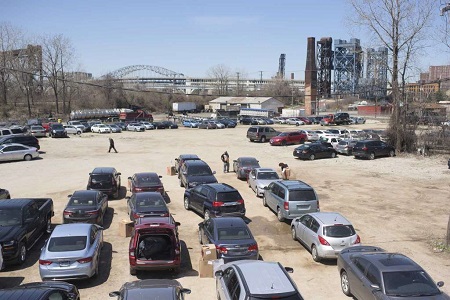
Back in February, The Washington Post reporter Todd Frankel, reached out to a number of us in the industry, or writing about it, looking to do a story on LPR in the repossession industry. What he came up with, was a fair representation in my opinion, but he did fail to recognize or bring up the deeper problems the industry faces, but rather focused on the repossession act and LPR. A focus that their reading audience probably cares more about anyhow.
Cleveland, OH – 15 May 2018 – The computer in the spotter car shouted “Hide!” and repo agent Derek Lewis knew that meant to keep driving like nothing happened. He’d just found another wanted vehicle. He was about to ruin someone’s day. Best not to draw attention.
It helped that he wasn’t in a tow truck, the stereotypical image of a repo man. Lewis drove a beat-up Ford Crown Victoria sedan. It had four small cameras mounted on the trunk and a laptop bolted to the dash. The high-speed cameras captured every passing license plate. The computer contained a growing list of hundreds of thousands of vehicles with seriously late loans. The system could spot a repossession in an instant. Even better, it could keep tabs on a car long before the loan went bad.
Now, Lewis had a live hit in a parking lot. He glanced at his laptop. The plate matched a blue 2006 BMW 325xi. He twisted in his seat. “It’s right there,” he said.
Technology has made the repo man ruthlessly efficient, allowing this familiar angel of financial calamity to capitalize on a dark corner of the United States’ strong economy: the soaring number of people falling behind on their car payments.
No longer tethered to a tow truck and able to use big data to find targets, the repossession industry is booming at an unexpected time. Although the U.S. economy recently entered its second-longest-ever period of expansion, the auto loan delinquency rate last year reached its highest point since 2012, driven by souring subprime auto loans. It’s evidence of how the economic recovery has not been evenly felt, with some of Americans’ biggest purchases – automobiles – being fueled by unsustainable borrowing rather than rising wages.
And the repo man has noticed the change.
“So much of America is just a heartbeat away from a repossession – even good people, decent people who aren’t deadbeats,” said Patrick Altes, a veteran agent in Daytona Beach, Florida. “It seems like a different environment than it’s ever been.”
Repo agents are the unpopular foot soldiers in the nation’s $1.2 trillion auto loan market. They don’t make the loans or issue the repossession orders that, for some high-risk customers, can come as soon as a single payment is days late. But they are the closest most people come to a faceless, sophisticated financial system that can upend their lives.
Lewis rolled to a far corner of the parking lot, next to an apartment building overlooking Lake Erie, and called the BMW’s lender.
“I’m sitting on a live hit for you,” he said.
He texted for a company tow truck. It was seven minutes away. This was the hard part. He had to just hope the vehicle’s driver didn’t come out and drive away. It would be like watching a fish wiggle free of the hook.
He sat in silence, one of the few times his spotter car wasn’t logging new plates, each one trumpeted by a video-game-like bing. The system picked up passing cars. Parked cars. Cars stashed in driveways. As many as 10,000 every eight-hour shift.
Lewis compared each scan to planting a seed.
“Is it going to grow into a repo?” he said. “Or are they going to pay their bills?”
Lewis works for Relentless Recovery, the largest repo company in Ohio and its busiest collector of license plate scans. Last year, the company repossessed more than 25,500 vehicles – including tractor trailers and riding lawn mowers.
Business has more than doubled since 2014, the company said. Even with the rising deployment of remote engine cutoffs and GPS locators in cars, repo agencies remain dominant.
Relentless scanned 28 million license plates last year, a demonstration of its recent, heavy push into technology. It now has more than 40 camera-equipped vehicles, mostly spotter cars. Agents are finding repos they never would have a few years ago.
The company’s goal is to capture every plate in Ohio and use that information to reveal patterns. A plate shot outside an apartment at 5 a.m. tells you that’s probably where the driver spends the night, no matter their listed home address. So when a repo order comes in for a car, the agent already knows where to look.
“It’s kind of scary, but it’s amazing,” said Alana Ferrante, chief executive of Relentless.
Lewis, 33, got his start repossessing cars when he was 14, helping his dad tow vehicles in the dead of night. His dad moved on to construction. But Lewis kept at it, eventually getting burned out on chasing cars. He went to work as a firefighter and paramedic – which provoked very different reactions from people – before returning a few years ago to the job he knew best. And for a while, the job remained mostly the same. He’d prowl around in a tow truck, armed with paper orders and a map, just praying the target vehicle was parked where it was supposed to be.

That all changed in recent years.
Repos remain risky. Lewis has had a gun pointed at him three times and a cigarette stubbed out on his forehead once. He’s had people come out screaming at him. He’s seen them break down in tears.
Lewis, who as operations director still regularly does repos, tries to follow one main rule: “Don’t make someone’s bad situation worse.” So he avoided hospital parking lots. But he loved shopping malls, especially the last row of lots, where the employees park. Discount stores were another target.
“For getting a live hit, this is the place to be,” he said earlier, weaving his way past rows of cars outside a Dollar General.
It could feel like he was preying on the poor. Lewis said he just went where the repos were. Even then, repos clustered in unexpected ways. Lewis pointed to one apartment complex so stocked with repos it became his honey hole. Yet similar buildings nearby were repo deserts.
Nationwide, repo agents described a broadening base of people struggling to stay current on their auto loans. In the old days, agents picked up mostly entry-level cars – Chevy Chevettes and Dodge Neons.
“Now it’s all over the place,” said Altes, the Daytona Beach agent, who is also the former head of the repo trade group Time Finance Adjusters.
Agents today get assignments for high-end brands such as Mercedes-Benz. They take the new cars of Uber drivers. Relentless picked up its first 2018 model last year, just weeks after it debuted. The only cars still rarely seen are Subarus and Volvos – the unflashy favorites of the urbane upper middle class.
Now, Lewis kept his eye on the blue BMW, a vehicle that might cost $37,000 new but after more than a decade was worth less than $8,000. The tow truck rolled up. Lewis slipped on a pair of work gloves.
“You ready?” he shouted at the tow truck driver.
The best repo is a quick “hook and roll.” This wasn’t one of them. The BMW had all-wheel drive. All four wheels needed to be off the ground. The tow truck swung its lift under the rear tires of the backed-in BMW. Lewis and the tow driver jumped out to assemble a metal dolly to raise the front tires. Time crawled. Lewis scanned the lot. A woman walked toward them. He watched with relief as she climbed into a different car.
“See you, guys,” the tow truck driver shouted, pulling away with the bounty – worth about $400 to Relentless.
First repo of the day. Thousands of seeds planted.
– – –
Although there are no national auto repossession statistics, other measures point to a growing problem. More than 4 percent of auto loans were at least 90 days late at the end of 2017 – the highest rate in five years. That number jumps to almost 10 percent for subprime auto loans alone, according to a report by the Federal Reserve Bank of New York.
Affordability is one factor. The average new car price has soared 20 percent over a decade, to $35,500, while wages have been sluggish. Auto loans now carry higher balances and longer terms, stretching out the timeline for trouble to appear.
Analysts point to a period from 2014 to 2016, when auto lenders got too loose with credit. That helped the United States sell a record number of automobiles in 2016. But it also pushed the delinquency rate higher.
“As a result, the markets pulled back a little bit,” said Amy Crews Cutts, chief economist at Equifax.
The rate of auto loan write-offs – which includes repos – is trending higher but remains below its 2009 peak, according to Equifax numbers.
Repo agents have their own theories about what’s going on – from fading attachment to vehicles to an increased willingness to walk away, a lesson learned from the housing crisis. One national list of active automobile repossession orders reached 360,000 this year, more than double what it was at the same time last year.
Lewis believed the industry followed a pulse. April was always slow because people made car payments with tax refunds. But repos soared on bad news, such as with the loss of 1,500 autoworker jobs in Lordstown, Ohio, announced this year. Lewis recently heard that a nuclear power plant near Cleveland might shutter.
“I expect we’ll see some from that,” he said.
His own industry has seen changes, too. Regulators, led by the Consumer Financial Protection Bureau, have cracked down on the job’s outlaw attitude. Lenders have pushed agents to take certification courses. Last year, Relentless switched its 120 workers from contractors to employees in an effort to change the culture and its incentives.
The camera systems have made agents more productive but also opened them up to new challenges.
Repo agents are responsible for the majority of the billions of license plate scans produced nationwide. But they don’t control the information. Most of that data is owned by Digital Recognition Network (DRN), a Fort Worth company that is the largest provider of license-plate-recognition systems. And DRN sells the information to insurance companies, private investigators – even other repo agents.
DRN is a sister company to Vigilant Solutions, which provides the plate scans to law enforcement, including police and U.S. Immigration and Customs Enforcement. Both companies declined to respond to questions about their operations. The potential misuse of the plate data has drawn criticism from privacy groups. A federal court in Nevada ruled in January that the scans do not amount to unwarranted surveillance because they are essentially snapshots taken in public.
Still, officials in Alameda, California, this year put on hold a contract to buy Vigilant’s technology over worries the scans could be used for federal immigration enforcement.
For repo companies, one worry is whether they are producing information that others are monetizing.
 – – –
– – –
Now it was after midnight and Lewis was back at work, trying to rouse himself with Red Bull. This time he drove a tow truck. And he had his eye on a potential repo: a 2016 Chevy Cruze.
The order was only a few hours old. Half of Relentless’s repos are found within the first two days. After 10 days, most vehicles disappear.
But Lewis had a plate scan for the Chevy taken five days earlier, at 8:39 a.m. outside an apartment complex. He bet that was the car owner’s home.
Lewis loved being back in a hulking Ford F-450. Moving to a spotter car had been “like getting neutered,” he said. But he realized the change was better for business.
“I had to ask myself, ‘Do I want to make money, or do I want to look like a tough guy in a tow truck?’ ” he said.
He pulled up to a quiet garden-style apartment complex. The plate scan’s GPS coordinates pointed to exactly where the car should be. And it was.
The tow truck’s rumble seemed impossibly loud. Darkened apartment windows lined the parking lot. Lewis backed up the truck and guided the lift. He jumped out with a flashlight and verified it was the right car. He got back in, lifted the vehicle higher and pulled away. A real hook and roll.
Safely out of sight, he pulled over to inspect the vehicle. He could see a woman’s sunglasses in the front console. A “black ice” air freshener and knickknacks dangled from the rearview mirror. In the back was a child’s car seat.
Lewis didn’t flinch. He knew a mother was probably going to walk outside in the morning and realize her car was gone. She might call the police to report it stolen. But she had to have known this moment was coming after a flurry of lender late notices and phone calls. Lewis understood. What do you do against the inevitable? He has four children of his own. He had paid to get strangers’ cars out of repo before. But this was his job. He’d been doing it most of his life. And technology hadn’t yet figured out how to soften the blow.
After her car was towed to Relentless, the woman’s personal items would be stored in a cardboard box, amid the stacks of boxes from other repos. The car might be gone, the missed payments and repo fee too much to make up, but she could get her items back for $50.
The repo man had a policy, part of that aim to not make a bad situation worse.
The child’s car seat was always returned for free.
Story by: Todd C. Frankel, The Washington Post











Facebook Comments